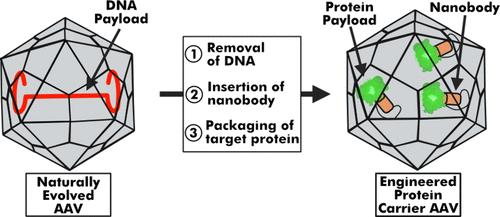蛋白载体腺相关病毒
IF 16
1区 材料科学
Q1 CHEMISTRY, MULTIDISCIPLINARY
引用次数: 0
摘要
腺相关病毒(AAV)已成为基因治疗的主要平台,使治疗性DNA能够传递到靶细胞。然而,AAV传递蛋白质有效载荷的潜力尚未得到探索。在这项研究中,我们设计了一种蛋白质载体AAV (pcAAV),通过在内部衣壳表面插入结合域来包装和传递蛋白质。在衣壳组装过程中,这些结合域通过与同源肽或蛋白质标签的相互作用介导特定靶蛋白的包装。我们展示了多种蛋白质的包装,包括绿色荧光蛋白、化脓性链球菌Cas9、Cre重组酶和工程过氧化物酶APEX2。包装效率受结合结构域插入位点、含有结合结构域的病毒蛋白异构体以及靶蛋白的亚细胞定位等因素的调节。我们证明pcAAV可以进入细胞并传递蛋白质负载,并且酶在包装后保持其活性。重要的是,这种蛋白质包装能力可以转化为多种AAV血清型。我们的工作建立了AAV作为蛋白质递送载体,显着扩展了这种病毒载体在生物医学应用中的效用。本文章由计算机程序翻译,如有差异,请以英文原文为准。

Protein Carrier Adeno-Associated Virus
Adeno-associated virus (AAV) has emerged as a leading platform for gene therapy, enabling the delivery of therapeutic DNA to target cells. However, the potential of AAV to deliver protein payloads has been unexplored. In this study, we engineered a protein carrier AAV (pcAAV) to package and deliver proteins by inserting binding domains on the interior capsid surface. These binding domains mediate the packaging of specific target proteins through interaction with cognate peptides or protein tags during the capsid assembly process. We demonstrate the packaging of multiple proteins, including green fluorescent protein, Streptococcus pyogenes Cas9, Cre recombinase, and the engineered peroxidase APEX2. Packaging efficiency is modulated by the binding domain insertion site, the viral protein isoform containing the binding domain, and the subcellular localization of the target protein. We show that pcAAV can enter cells and deliver the protein payload and that enzymes retain their activity after packaging. Importantly, this protein packaging capability can be translated to multiple AAV serotypes. Our work establishes AAV as a protein delivery vehicle, significantly expanding the utility of this viral vector for biomedical applications.
求助全文
通过发布文献求助,成功后即可免费获取论文全文。
去求助
来源期刊

ACS Nano
工程技术-材料科学:综合
CiteScore
26.00
自引率
4.10%
发文量
1627
审稿时长
1.7 months
期刊介绍:
ACS Nano, published monthly, serves as an international forum for comprehensive articles on nanoscience and nanotechnology research at the intersections of chemistry, biology, materials science, physics, and engineering. The journal fosters communication among scientists in these communities, facilitating collaboration, new research opportunities, and advancements through discoveries. ACS Nano covers synthesis, assembly, characterization, theory, and simulation of nanostructures, nanobiotechnology, nanofabrication, methods and tools for nanoscience and nanotechnology, and self- and directed-assembly. Alongside original research articles, it offers thorough reviews, perspectives on cutting-edge research, and discussions envisioning the future of nanoscience and nanotechnology.
 求助内容:
求助内容: 应助结果提醒方式:
应助结果提醒方式:


